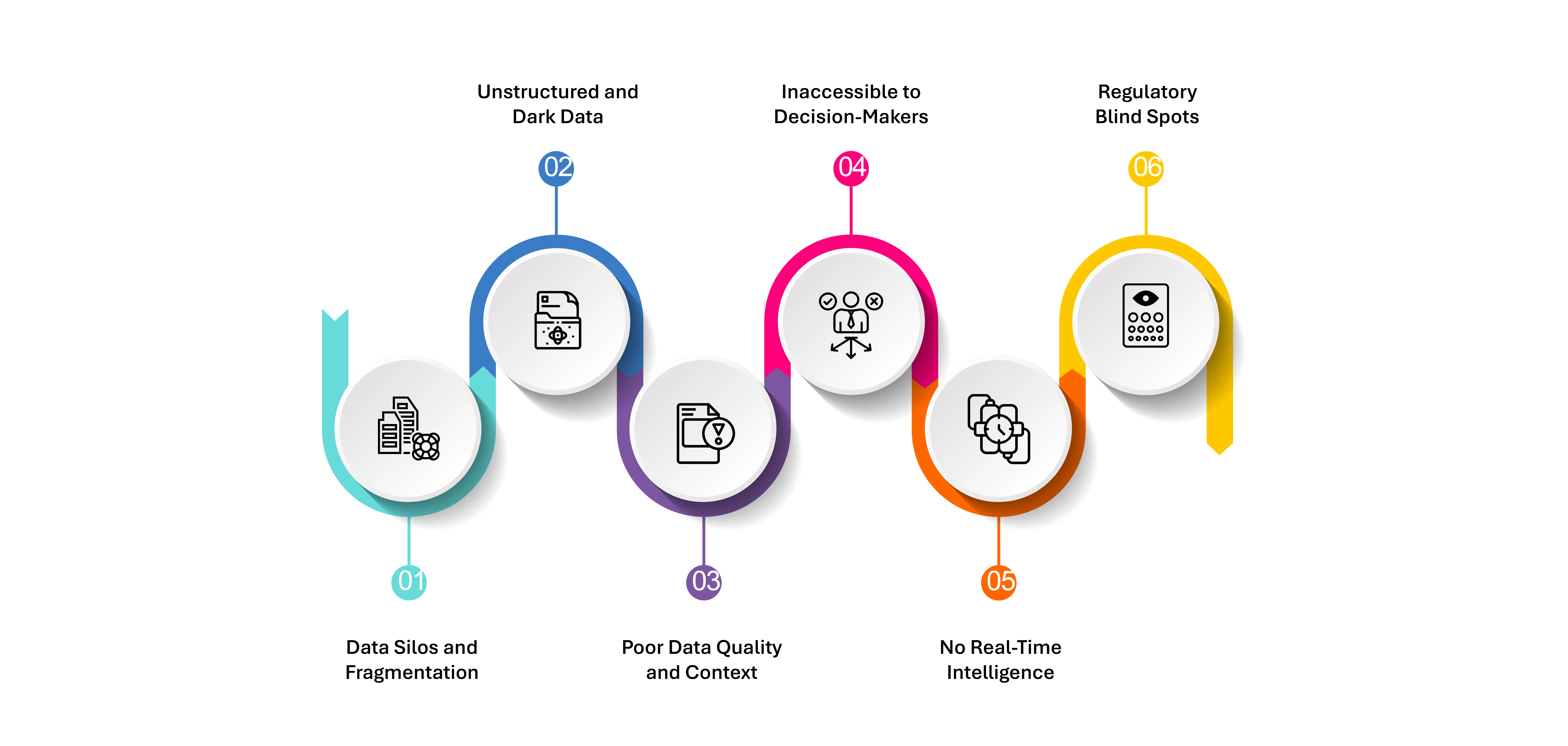What are Data Insights?
Data insights are meaningful interpretations extracted from raw data that inform decisions, reveal trends, and power strategic outcomes. They go beyond numbers to provide context, clarity, and foresight—enabling businesses to act with precision across operations, compliance, customer engagement, and innovation.
Why It Matters
In a world where every click, interaction, and transaction generates data, the competitive advantage no longer lies in data possession—but in the ability to extract its value. Data insights are what transform inert data into intelligence, enabling organizations to move from hindsight to foresight.
Whether it’s anticipating supply chain risks, identifying revenue leakage, improving patient outcomes, or shaping policy decisions, insights turn strategy from reactive to predictive. They are the foundation of AI accuracy, operational agility, and digital trust. Without insights, data is just a liability; with them, it becomes an asset.
Types of Data Insights
- Descriptive Insights: What happened?
- Diagnostic Insights: Why did it happen?
- Predictive Insights: What’s likely to happen next?
- Prescriptive Insights: What should we do about it?
- Cognitive Insights: How do we simulate human decision-making?
These layers build upon one another, creating a hierarchy of intelligence that spans operations, compliance, customer experience, and growth.
Challenges in Unlocking Data Insights – And What to Do

Data Silos and Fragmentation
Data lives across clouds, apps, and teams, limiting enterprise-wide visibility.
What to Do: Implement data fabric or mesh architectures to enable unified discovery, access, and insight generation across ecosystems.
Unstructured and Dark Data
Documents, images, audio, logs—most enterprise data is unstructured and invisible to traditional BI tools.
What to Do: Use AI-powered engines to enrich, classify, and contextualize unstructured data for insight-readiness.
Poor Data Quality and Context
Inaccurate, outdated, or decontextualized data leads to misleading insights.
What to Do: Embed data quality management and metadata tagging into every stage of the data lifecycle.
Inaccessible to Decision-Makers
Insights often remain stuck with data scientists or IT, delaying business impact.
What to Do: Deploy self-service analytics platforms that enable non-technical users to explore and act on data securely.
No Real-Time Intelligence
Static dashboards are obsolete in fast-moving environments.
What to Do: Integrate real-time analytics and observability tools to deliver live, event-driven insights at the point of decision.
Regulatory Blind Spots
Insights derived from personal or sensitive data without proper governance can lead to compliance risks.
What to Do: Ensure insights pipelines are compliant by integrating lineage, masking, and privacy-aware algorithms into workflows.
Insight-Led Innovation: Turning Intelligence into Action
The real value of data insights lies not in their availability but in their ability to catalyze intelligent action. When insights are embedded into the everyday workflows of marketing, finance, operations, and risk management, they become decision accelerators, enabling faster course corrections, real-time personalization, and operational precision at scale.
In AI development, insights shape model training, reduce drift, and improve explainability. In cybersecurity, they detect anomalies before breaches escalate. In ESG reporting, insights quantify carbon emissions, highlight energy inefficiencies, and reveal opportunities for responsible innovation. Across industries, insight-driven strategies are redefining how businesses compete, comply, and connect with customers.
But insight without action is insight wasted. Enterprises that build feedback loops—where insights inform processes, and processes refine insights—unlock a cycle of continuous improvement. That’s the competitive edge: a living, learning enterprise that evolves in sync with data.
Data Insights in the AI Age: Powering Trust, Transparency, and Control
As generative AI and large-scale automation redefine enterprise operations, data insights are no longer just analytical tools—they are ethical instruments. With every AI recommendation, customer interaction, or automated decision, enterprises face growing scrutiny over how those outcomes were generated.
Was the data used legally? Was the inference unbiased? Can it be explained, traced, and justified under GDPR, CCPA, or India’s DPDP Act?
This is where insights must evolve from outputs to accountable systems. Enterprises are now expected to show their work—embedding explainability, data provenance, and algorithmic fairness into every insight pipeline. This requires a foundation of strong data governance: metadata tagging, lineage tracking, access control, and privacy-preserving computation. Only then can insights be both actionable and defensible.
In the AI age, insight delivery must coexist with digital trust. Leaders who can make transparency a native feature of their insight infrastructure will earn a lasting advantage across regulators, partners, and end-users.
The Future of Data Insights: Contextual. Autonomous. Embedded.
The next evolution of data insights is already underway—and it’s frictionless, federated, and AI-native.
Imagine a world where insights surface automatically, without dashboards, reports, or analyst intervention. In this future, autonomous engines scan enterprise data continuously, drawing real-time conclusions and injecting them directly into business workflows: an alert in a CISO’s security console, a sales forecast suggestion in a CRM, or a privacy compliance flag during a product launch.
These insights will be contextual, understanding user intent, role, and risk; autonomous, able to adjust, learn, and escalate as environments change; and embedded, appearing at the point of decision, whether in mobile apps, productivity tools, or even extended reality environments.
This isn’t about replacing human intelligence—it’s about augmenting it at scale. Data-driven decisions won’t be reserved for data scientists or executive reports. They’ll be democratized, secured, and automated—so that every employee, every system, and every process becomes insight-aware by design.
In this new era, the winners won’t be those with the most data, but those with the most usable, trustworthy, and timely insights.
Getting Started with Data Dynamics:
- Learn about Unstructured Data Management
- Schedule a demo with our team
- Read the latest blog: Does Data Localization Alone Guarantee Privacy? The Unspoken Challenges






